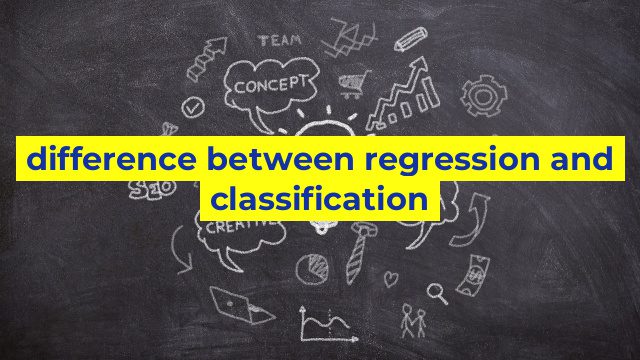Regression vs. Classification: Key Differences and Use Cases
When it comes to data analysis and machine learning, two of the most commonly used techniques are regression and classification. While both are statistical models that analyze relationships between variables, they have fundamental differences in their purpose and methodology. In this article, we’ll explore the differences between regression and classification, and the situations in which each is most appropriate.
Overview of Regression
Regression is a method of estimating the relationship between a dependent variable (also known as the outcome or response variable) and one or more independent variables (also known as predictors or explanatory variables). Regression models are used to understand how changes in one variable affect another, and to make predictions based on historical data. Regression models can be linear or non-linear, and can handle continuous or categorical data.
Some common use cases for regression include:
– Predicting the value of a stock based on its historical prices and other market factors
– Forecasting future sales revenue based on past performance and macroeconomic indicators
– Estimating the effect of advertising spending on customer engagement and sales
– Analyzing the impact of demographic variables (age, income, education) on voting behavior
Overview of Classification
Classification is a method of categorizing data into predefined groups or classes based on their characteristics. It is used to build models that can predict the class of an unknown data point based on its features. Unlike regression, classification models are designed to handle discrete data, such as categories or binary outcomes (e.g. yes/no, true/false).
Some common use cases for classification include:
– Spam detection in email filtering
– Credit risk assessment for loan applications
– Animal or plant species identification based on visual or genetic features
– Medical diagnosis of diseases based on symptoms or lab results
Key Differences Between Regression and Classification
The key differences between regression and classification can be summarized as follows:
– Purpose: Regression is used to model the relationship between a dependent variable and independent variables in order to make predictions, whereas classification is used to categorize data into predefined groups based on their characteristics.
– Types of Data: Regression can handle continuous and categorical data, while classification is designed for discrete data only.
– Output: Regression produces a continuous output value (such as a predicted stock price or customer engagement score), while classification produces a discrete output value (such as a spam/ham label or disease diagnosis).
– Model Selection: Regression models can be linear or non-linear, while classification models can be binary or multi-class (i.e. more than two possible outcomes).
– Evaluation Metrics: Regression models are typically evaluated using metrics such as mean squared error (MSE) or R-squared, while classification models are evaluated using metrics such as accuracy, precision, and recall.
Conclusion
Regression and classification are two essential techniques in data analysis and machine learning, but they have different purposes and methodologies. Understanding the differences between the two can help you choose the right tool for the job, whether you’re trying to predict stock prices or diagnose diseases. By selecting the appropriate model and evaluation metrics, you can ensure that your analysis is accurate and insightful.
Table difference between regression and classification
| Regression | Classification |
|---|---|
| Regression is a statistical method used to find the relationship between a dependent variable and one or more independent variables. | Classification is a machine learning method used to categorize data into predefined groups based on input features and labeled data. |
| Regression aims to predict a continuous numerical output. | Classification aims to predict a discrete categorical output. |
| Examples of regression problems include predicting the price of a house, the stock price, or the temperature. | Examples of classification problems include spam email detection, sentiment analysis, or identifying different types of flowers. |
| Regression models can be linear or nonlinear. | Classification models can be binary or multiclass. |
| Regression models are evaluated using metrics such as mean squared error, mean absolute error, and R-squared. | Classification models are evaluated using metrics such as accuracy, precision, recall, F1-score, and confusion matrix. |
